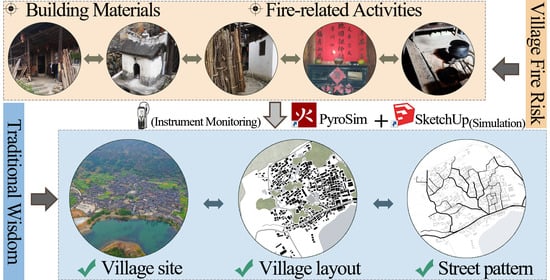The Traditional Wisdom in Fire Prevention Embodied in the Layout of Ancient Villages: A Case Study of High Chair Village in Western Hunan, China
Abstract
1. Introduction
2. Methodology
2.1. Study Area
2.2. Field Research
2.2.1. Village Layout
- (1)
- Location Selection
- (2)
- Village Layout
- (3)
- Street Layout
2.2.2. Village Fire Risk
- (1)
- Building Materials
- (2)
- Fire Load of Dwellings
- (3)
- Fire-related Activities
2.3. Monitoring
2.3.1. Open-Space Windspeed
2.3.2. Street Windspeed
2.4. Software Simulations
2.4.1. The Impact of Village Layout on Fires
- (1)
- Simulation Model
- (2)
- Simulation Grid
- (3)
- Fire Source
- (4)
- Material Parameters
- (5)
- Wind Speed
2.4.2. The Impact of Street Morphology on the Spread of the Fire
- Wind direction. Considering the most hazardous situation, the wind direction was set to the northeast wind commonly encountered in western Hunan, which was the same as the direction of the street. The windspeed was set to 1.5 m/s for both models.
- The grid size was 0.6 m × 0.6 m × 0.6 m for both models. The grid numbers of the straight street and the crooked street were 92,664 and 86,400, respectively.
- The size of the fire source was set to 1 m × 1 m and it was set up in a residential room at a certain distance from the windbreak to reflect the wind-blocking performance of the streets with different forms more obviously. The simulation time was set to 3600 s.
3. Results
3.1. Field Research Results
3.1.1. Village Layout
3.1.2. Street Layout
3.1.3. Material Moisture Content
3.1.4. Fire Load of Dwellings
3.2. Monitoring Results
3.2.1. Open-Space Windspeed
3.2.2. Street Windspeed
3.3. Software Simulation Results
3.3.1. Fire Simulation Results for Different Village Layouts
3.3.2. Fire Simulation Results for Different Street Patterns
4. Discussion of Traditional Fire-Prevention Wisdom of Ancient Villages
4.1. Location
4.2. Village Layout
4.3. Street Layout
5. Conclusions
- The results of this study show that the ancient villages in western Hunan have their own particular potential fire risks. For example, the average moisture content of wood in ancient village houses in High chair village was only 10%, more than 90% of the inhabitants stocked a large amount of dry firewood outside the kitchen for kitchen cooking or fire pits, and there were frequent traditional fire-related rituals. In addition, the fire-fixed load density of the dwellings in High chair village was 1700–2753 MJ/m2, around 4–6.6-times that of modern dwellings. The average widths of the main streets and secondary streets were 3.40 m and 2.39 m, respectively, which do not meet the fire spacing regulations of Chinese wooden dwellings. However, these ancient villages have survived for millennia and it is crucial to explore their traditional disaster-mitigation methods and pass them on to future generations.
- The monitoring results show that the village layout of High chair Village, sheltered from the wind and gathering Qi, was conducive to the formation of a stable wind environment to reduce the risk of fire spread. The maximum windspeed (3.21 m/s) and the average windspeed (2.28 m/s) in the open space of Shujiatang Village were about 2.3-times and 3.4-times that of High chair Village (1.40 m/s and 0.67 m/s), respectively. The average windspeeds of the main streets, straight streets, and crooked streets in High chair Village are 0.68 m/s, 0.60 m/s, and 0.18 m/s, respectively. More than 70% of the streets and lanes in High chair Village were in the crooked street category. The windspeed was weakened by the crooked streets and alleys, and in case of fire, this street environment was also conducive to slowing down the spread of fire.
- The simulation results show that for the same windspeed (2.28 m/s) conditions, the number of dwellings burning increased twice-more rapidly over time for the village layout that was not sheltered from the wind. In addition, the burning of dwellings in crooked streets during the simulation period was less serious than that in straight streets. The simulation results were consistent with the monitoring results.
- The “survival design” of village siting, village layout, and street pattern of ancient villages in western Hunan are also applicable in modern rural development in China, especially in remote mountainous areas. As we are fortunate to be able to access this traditional wisdom, it is our responsibility to learn from our ancestors and apply the derived knowledge alongside modern technology to disaster-mitigation measures in a contemporary context and to continue to develop and pass it on to future generations.
Author Contributions
Funding
Data Availability Statement
Conflicts of Interest
Appendix A
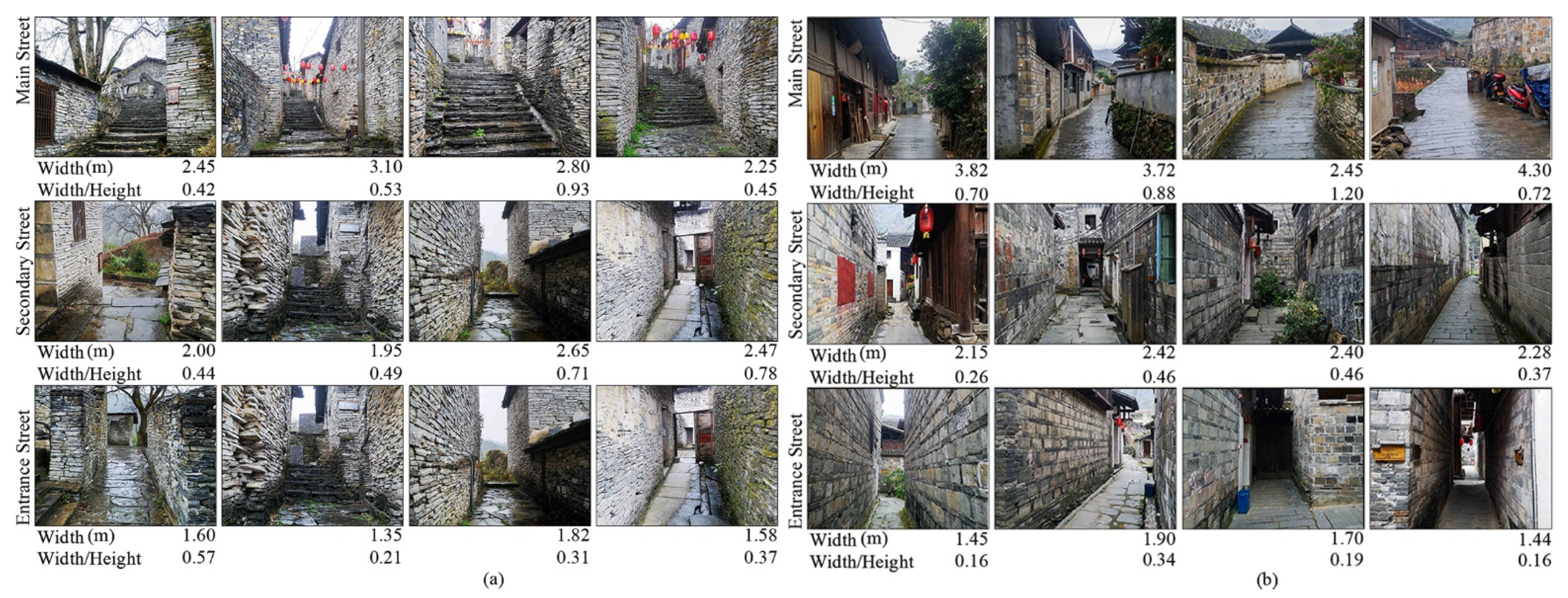
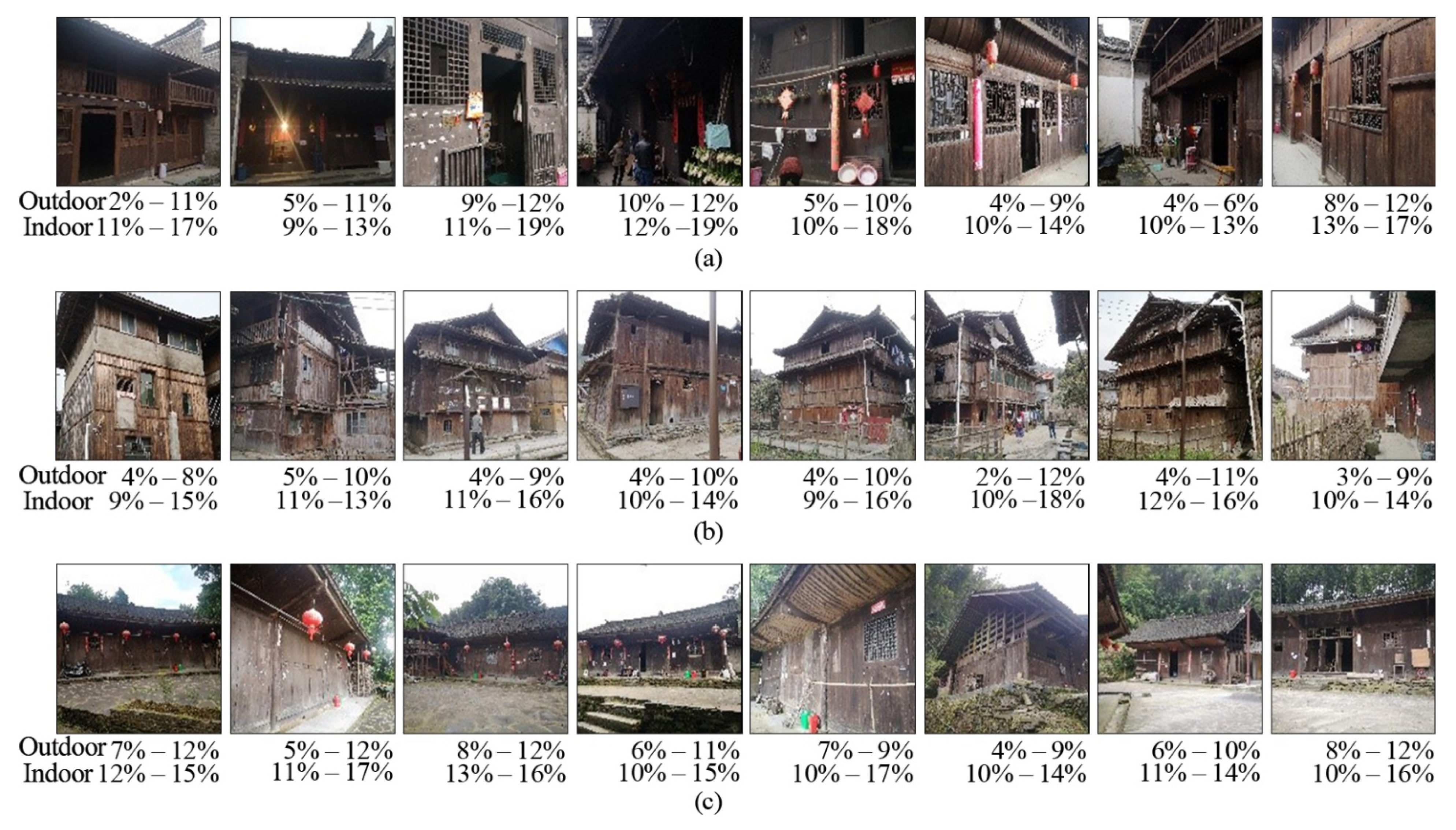
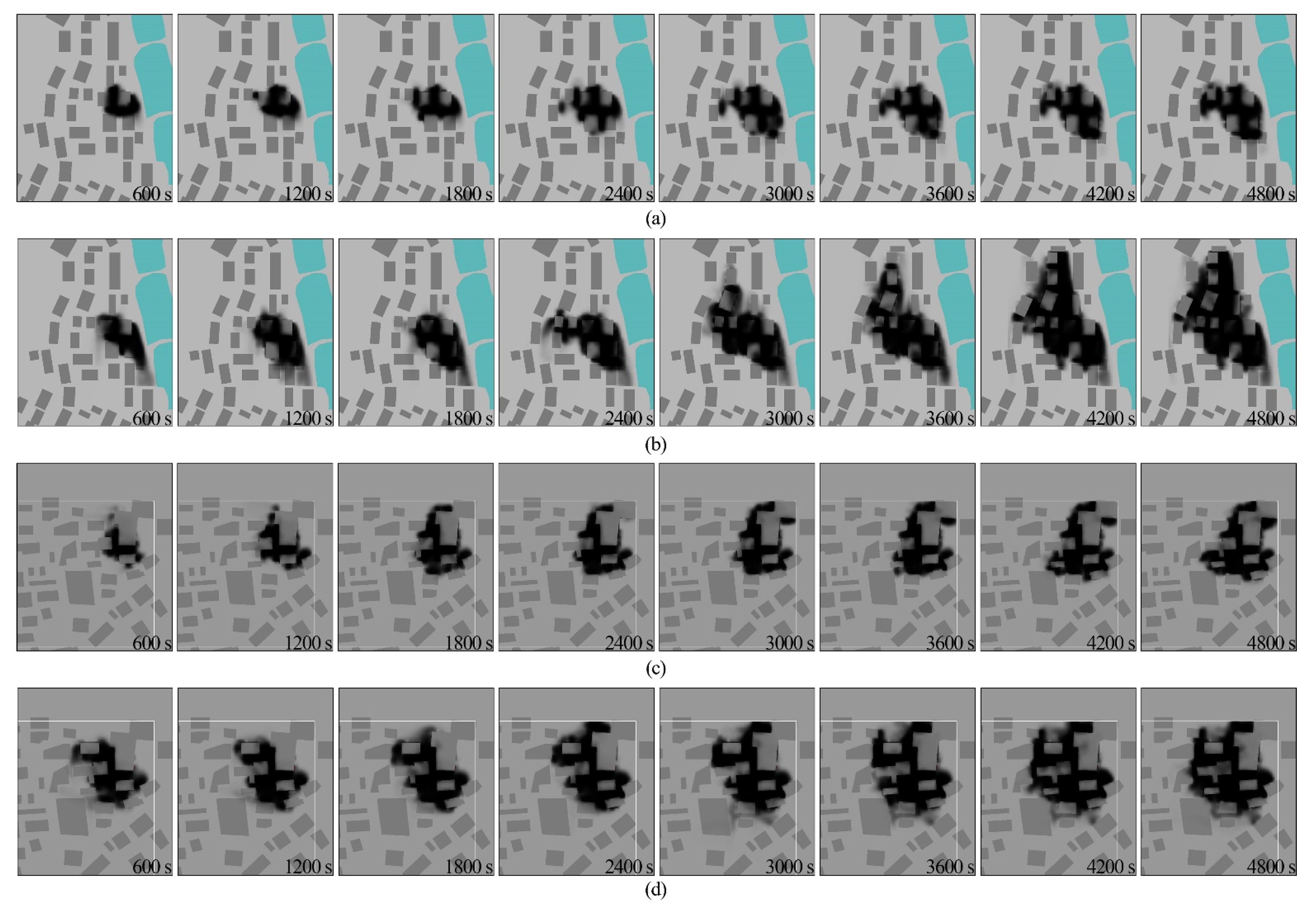
| Owner | Gable Material | Bay Number | Wood Amount/m3 | Building Area/m2 | ||
|---|---|---|---|---|---|---|
| Roof Frame | Floor Stairs | Walls | ||||
| Yang. Y | Brick | 2 | 8.71 | 2.39 | 6.91 | 75 |
| Yang. H | half-timbered | 3 | 14.05 | 4.32 | 21.56 | 138 |
| Yang. R | half-timbered | 4 | 15.34 | 3.63 | 21.31 | 118 |
| Yang. F | half-timbered | 3 | 13.87 | 4.36 | 22.78 | 141 |
| Huang. Y | half-timbered | 4 | 20.38 | 7.58 | 33.20 | 255 |
| Yang. G | Timber | 3 | 12.75 | 3.43 | 18.59 | 116 |
| Yang. F | half-timbered | 3 | 14.84 | 5.66 | 29.52 | 185 |
| Yang. R | half-timbered | 3 | 13.73 | 4.47 | 21.60 | 147 |
| Ju. G | half-timbered | 4 | 16.88 | 4.91 | 24.11 | 164 |
| Yang. F | half-timbered | 3 | 13.79 | 4.41 | 23.21 | 148 |
| Yang. R | half-timbered | 3 | 13.05 | 3.65 | 19.48 | 121 |
| Ming. Y | half-timbered | 1 | 5.45 | 1.34 | 7.69 | 45 |
| Yang. Y | half-timbered | 5 | 20.78 | 7.52 | 37.66 | 254 |
| Huang. J | half-timbered | 3 | 15.31 | 5.95 | 26.50 | 199 |
| Yang. F | brick | 3 | 14.28 | 5.38 | 19.99 | 180 |
| Ming. H | Brick | 3 | 13.53 | 5.02 | 17.90 | 166 |
| Yang. Y | Timber | 3 | 12.19 | 3.15 | 13.08 | 105 |
| Yang. J | half-timbered | 3 | 15.02 | 6.07 | 23.84 | 187 |
| Yang. J | half-timbered | 3 | 14.18 | 4.47 | 24.08 | 147 |
| Xiang. P | Brick | 3 | 11.89 | 3.61 | 11.79 | 119 |
| Wu, Y | half-timbered | 4 | 15.63 | 4.68 | 13.54 | 154 |
| Yang. G | half-timbered | 3 | 13.34 | 4.34 | 12.60 | 144 |
| Yang. G | Timber | 3 | 12.08 | 3.36 | 11.86 | 114 |
References
- Romão, X.; Bertolin, C. Risk protection for cultural heritage and historic centres: Current knowledge and further research needs. Int. J. Disaster Risk Reduct. 2022, 67, 102652. [Google Scholar] [CrossRef]
- Kobes, M.; Helsloot, I.; de Vries, B.; Post, J.G. Building safety and human behaviour in fire: A literature review. Fire Saf. J. 2010, 45, 1–11. [Google Scholar] [CrossRef]
- Liu, T.; Jiao, H. How does information affect fire risk reduction behaviors? Mediating effects of cognitive processes and subjective knowledge. Nat. Hazard. 2018, 90, 1461–1483. [Google Scholar] [CrossRef]
- Wu, H. The changing Xiangxi Miao marriage practices in contemporary China. Asian Ethn. 2013, 14, 189–205. [Google Scholar] [CrossRef]
- Shao, Y.; Chen, Y.; Su, J. Understanding of the settlements with coexisting water and earth under the background of climate change—The case of Liang Village in Pingyao County, China. Built Herit. 2022, 6, 22. [Google Scholar] [CrossRef]
- Yuan, C.; He, Y.; Feng, Y.; Wang, P. Fire hazards in heritage villages: A case study on Dangjia Village in China. Int. J. Disaster Risk Reduct. 2018, 28, 748–757. [Google Scholar] [CrossRef]
- Du, F.; Okazaki, K.; Ochiai, C. Disaster coping capacity of a fire-prone historical dong village in China: A case study in Dali Village, Guizhou. Int. J. Disaster Risk Reduct. 2017, 21, 85–98. [Google Scholar] [CrossRef]
- Huai, C.; Xie, J.; Liu, F.; Du, J.; Chow, D.H.C.; Liu, J. Experimental and numerical analysis of fire risk in historic Chinese temples: A case in Beijing. Int. J. Arch. Herit. 2021, 1–15. [Google Scholar] [CrossRef]
- Zhang, F.; Shi, L.; Liu, S.; Shi, J.; Zhang, J. CFD-based framework for fire risk assessment of contiguous wood-frame villages in the western Hunan region. J. Build. Eng. 2022, 54, 104607. [Google Scholar] [CrossRef]
- Huang, H.; Li, L.; Gu, Y. Assessing the accessibility to fire hazards in preserving historical towns: Case studies in suburban Shanghai, China. Front. Archit. Res. 2022, 11, 731–746. [Google Scholar] [CrossRef]
- Zheng, Y. Analysis on the application and technology of the five elements in Chinese ancient buildings. For. Chem. Rev. 2022, 1260–1268. [Google Scholar] [CrossRef]
- Li, L. Simulation analysis of traditional fire prevention measures in ancient building. Fire Sci. Technol. 2021, 40, 1332. [Google Scholar] [CrossRef][Green Version]
- Okubo, T. Traditional wisdom for disaster mitigation in history of Japanese Architectures and historic cities. J. Cult. Herit. 2016, 20, 715–724. [Google Scholar] [CrossRef]
- Cheng, W.Y.G.; Lo, S.M.; Fang, Z.; Cheng, V.X. A view on the means of fire prevention of ancient Chinese building—From religious belief to practice. Struct. Surv. 2004, 22, 201–209. [Google Scholar] [CrossRef]
- Wang, Y.; Wang, W.; Zhou, H.; Qi, F. Burning Characteristics of Ancient Wood from Traditional Buildings in Shanxi Province, China. Forests 2022, 13, 190. [Google Scholar] [CrossRef]
- Tozo Neto, J.; Ferreira, T.M. Assessing and mitigating vulnerability and fire risk in historic centres: A cost-benefit analysis. J. Cult. Herit. 2020, 45, 279–290. [Google Scholar] [CrossRef]
- Gulum, P.; Ayyildiz, E.; Taskin Gumus, A. A two level interval valued neutrosophic AHP integrated TOPSIS methodology for post-earthquake fire risk assessment: An application for Istanbul. Int. J. Disaster Risk Reduct. 2021, 61, 102330. [Google Scholar] [CrossRef]
- Choi, M.-Y.; Jun, S. Fire risk assessment models using statistical machine learning and optimized risk indexing. Appl. Sci. 2020, 10, 4199. [Google Scholar] [CrossRef]
- Hansen, N.D.; Steffensen, F.B.; Valkvist, M.; Jomaas, G.; Van Coile, R. A fire risk assessment model for residential high-rises with a single stairwell. Fire Saf. J. 2018, 95, 160–169. [Google Scholar] [CrossRef]
- Granda, S.; Ferreira, T.M. Assessing vulnerability and fire risk in old urban areas: Application to the historical centre of guimarães. Fire Technol. 2019, 55, 105–127. [Google Scholar] [CrossRef]
- Zahmatkesh, F.; Memari, A.M. Review of conventional and innovative technologies for fire retrofitting of existing buildings. Open J. Civ. Eng. 2017, 7, 222–244. [Google Scholar] [CrossRef][Green Version]
- Johnson, P.; Lobel, N. Fire safety verification method—The Australia research experience. J. Phys. Conf. Ser. 2018, 1107, 042033. [Google Scholar] [CrossRef]
- Kristoffersen, M.; Log, T. Experience gained from 15 years of fire protection plans for Nordic wooden towns in Norway. Saf. Sci. 2022, 146, 105535. [Google Scholar] [CrossRef]
- Arvidson, M. Experience with fire suppression installations for wood churches in Sweden. J. Fire. Prot. Eng. 2008, 18, 141–159. [Google Scholar] [CrossRef]
- Zhang, J.; Long, B.; Zhao, Y. Creative destruction and commercialization of traditional villages: Likeng, Wangkou, and Jiangwan in Wuyuan, China. IOP Conf. Ser.: Mater. Sci. Eng. 2019, 592, 012109. [Google Scholar] [CrossRef]
- Xu, Q.; Wang, J. Recognition of Values of Traditional Villages in Southwest China for Sustainable Development: A Case Study of Liufang Village. Sustainability 2021, 13, 7569. [Google Scholar] [CrossRef]
- Chuvieco, E.; Wagtendonk, J.; Riaño, D.; Yebra, M.; Ustin, S.L. Estimation of Fuel Conditions for Fire Danger Assessment. In Earth Observation of Wildland Fires in Mediterranean Ecosystems; Chuvieco, E., Ed.; Springer: Berlin/Heidelberg, Germany, 2009; pp. 83–96. [Google Scholar]
- Islam, S.; Roman, R.I. Assessment of fire hazard on the readymade garment industry in Chittagong City, Bangladesh: A geospatial analysis of CEPZ and Baizid Industrial Hub. Indones. J. Environ. Manage. Sustain. 2019, 3, 20–28. [Google Scholar] [CrossRef]
- Joo, S.; Kim, S.; Kim, Y.; Park, C. Fire risk evaluation of bridge underneath conditions based on field investigation. Procedia Eng. 2017, 210, 582–587. [Google Scholar] [CrossRef]
- Sivrikaya, F.; Küçük, Ö. Modeling forest fire risk based on GIS-based analytical hierarchy process and statistical analysis in Mediterranean region. Ecol. Inf. 2022, 68, 101537. [Google Scholar] [CrossRef]
- Naziris, I.A.; Lagaros, N.D.; Papaioannou, K. Optimized fire protection of cultural heritage structures based on the analytic hierarchy process. J. Build. Eng. 2016, 8, 292–304. [Google Scholar] [CrossRef]
- Wang, Y.; Hou, L.; Li, M.; Zheng, R. A novel fire risk assessment approach for large-scale commercial and high-rise buildings based on fuzzy analytic hierarchy process (FAHP) and coupling revision. Int. J. Environ. Res. Public Health 2021, 18, 7187. [Google Scholar] [CrossRef]
- Chen, F.; Chen, J.; Liu, J. Comprehensive evaluation and optimization model of regional fire protection planning of major hazard sources based on multiobjective fuzzy theory. Comput. Intell. Neurosci. 2022, 2022, 3517836. [Google Scholar] [CrossRef]
- Guang-wang, Y.; Hua-li, Q. Fuzzy comprehensive evaluation of fire risk on high-rise buildings. Procedia Eng. 2011, 11, 620–624. [Google Scholar] [CrossRef]
- Bourhim, E.M.; Cherkaoui, A. Usability Evaluation of Virtual Reality-Based Fire Training Simulator Using a Combined AHP and Fuzzy Comprehensive Evaluation Approach. In Proceedings of the Data Intelligence and Cognitive Informatics, Singapore, 16–17 July 2021; pp. 923–931. [Google Scholar]
- Bernardini, G.; Azzolini, M.; D’Orazio, M.; Quagliarini, E. Intelligent evacuation guidance systems for improving fire safety of Italian-style historical theatres without altering their architectural characteristics. J. Cult. Herit. 2016, 22, 1006–1018. [Google Scholar] [CrossRef]
- Zhang, F.; Shi, L.; Liu, S.; Shi, J.; Shi, C.; Xiang, T. CFD-Based Fire Risk Assessment and Control at the Historic Dong Wind and Rain Bridges in the Western Hunan Region: The Case of Huilong Bridge. Sustainability 2022, 14, 12271. [Google Scholar] [CrossRef]
- Lotfi, N.; Behnam, B.; Peyman, F. A BIM-based framework for evacuation assessment of high-rise buildings under post-earthquake fires. J. Build. Eng. 2021, 43, 102559. [Google Scholar] [CrossRef]
- Huang, Y.H. The use of parallel computing to accelerate fire simulations for cultural heritage buildings. Sustainability 2020, 12, 10005. [Google Scholar] [CrossRef]
- Wang, K.; Wang, D.; Zhou, B.; Yang, W.; Wang, J.; Wang, W.; Wang, X. Influence of air gap ratio of the Chinese historical wooden window on the vertical flame spread performance. Therm. Sci. Eng. Prog. 2022, 32, 101308. [Google Scholar] [CrossRef]
- Adam, D.; Tassos, K.; Christos, K.; Stelios, C.A.T. ESTIA: A versatile platform for effective fire disaster management in cultural heritage sites and settlements. In Proceedings of the SPIE, Signal Processing, Sensor/Information Fusion, and Target Recognition XXXI, Orlando, FL, USA, 6 July 2022; p. 121220. [Google Scholar]
- Li, Y.; Ye, Y.; Fang, X.; Zheng, X.; Zhao, Z. Settlement expansion influenced by socio-cultural changes in western Hunan mountainous areas of China during the eighteenth century. J. Hist. Geogr. 2022. [Google Scholar] [CrossRef]
- Luo, M.; Liu, S. Study on Defensiveness of Ancient Dwellings in High-Chair Village of Huitong County of Hunan Province. Appl. Mech. Mater. 2012, 174–177, 3002–3007. [Google Scholar] [CrossRef]
- Hu, Z.; Strobl, J.; Min, Q.; Tan, M.; Chen, F. Visualizing the cultural landscape gene of traditional settlements in China: A semiotic perspective. Heritage Sci. 2021, 9, 115. [Google Scholar] [CrossRef]
- Kim, Y.J.; Park, S. Tectonic traditions in ancient Chinese architecture, and their development. J. Asian Archit. Build. Eng. 2018, 16, 31–38. [Google Scholar] [CrossRef]
- Badlan, R.L.; Sharples, J.J.; Evans, J.P.; McRae, R.H.D. Factors influencing the development of violent pyroconvection. Part I: Fire size and stability. Int. J. Wildland Fire 2021, 30, 484. [Google Scholar] [CrossRef]
- Benson, R.P.; Roads, J.O.; Weise, D.R. Chapter 2 Climatic and Weather Factors Affecting Fire Occurrence and Behavior. In Developments in Environmental Science; Bytnerowicz, A., Arbaugh, M.J., Riebau, A.R., Andersen, C., Eds.; Elsevier: Amsterdam, The Netherlands, 2008; Volume 8, pp. 37–59. [Google Scholar]
- Kropotova, S.S.; Kuznetsov, G.V.; Strizhak, P.A. Identifying products of pyrolysis and combustion of materials at incipient stages of fires. Fire Saf. J. 2022, 132, 103643. [Google Scholar] [CrossRef]
- Ministry of Housing and Urban-Rural Development of the Republic of China; Quality Supervision Inspection and Quarantine Bureau of the Republic of China. Technical Standards for Smoke Management Systems in Buildings GB 51251–2017; China Plan Press: Beijing, China, 2017.
- Makowiecki, A.S.; Steinbrenner, J.E.; Wimer, N.T.; Glusman, J.F.; Lapointe, C.B.; Daily, J.W.; Hamlington, P.E.; Rieker, G.B. Dual frequency comb spectroscopy of solid fuel pyrolysis and combustion: Quantifying the influence of moisture content in Douglas fir. Fire Saf. J. 2020, 116, 103185. [Google Scholar] [CrossRef]
- Zhang, F.; Shi, L.; Liu, S.; Shi, J.; Cheng, M. Indoor air quality in Tujia Dwellings in Hunan, China: Field tests, numerical simulations, and mitigation strategies. Int. J. Environ. Res. Public Health 2022, 19, 8396. [Google Scholar] [CrossRef]
- China Meteorological Administration. China Meteorological Data. Available online: http://www.cma.gov.cn/ (accessed on 8 October 2022).
- Cai, N.; Chow, W.-k. Numerical studies on heat release rate in a room fire burning wood and liquid fuel. Build. Simul. 2014, 7, 511–524. [Google Scholar] [CrossRef]
- Han, T. Fire Prevention in Ancient Buildings: Old Times and Today. Available online: https://news.sciencenet.cn/sbhtmlnews/2015/1/296514.shtm (accessed on 23 January 2022).
- Xu, L.; Zheng, W. Numerical simulation on the influence of low air pressure upon smoke spread and fire alarm process. Case Stud. Therm. Eng. 2021, 26, 101004. [Google Scholar] [CrossRef]

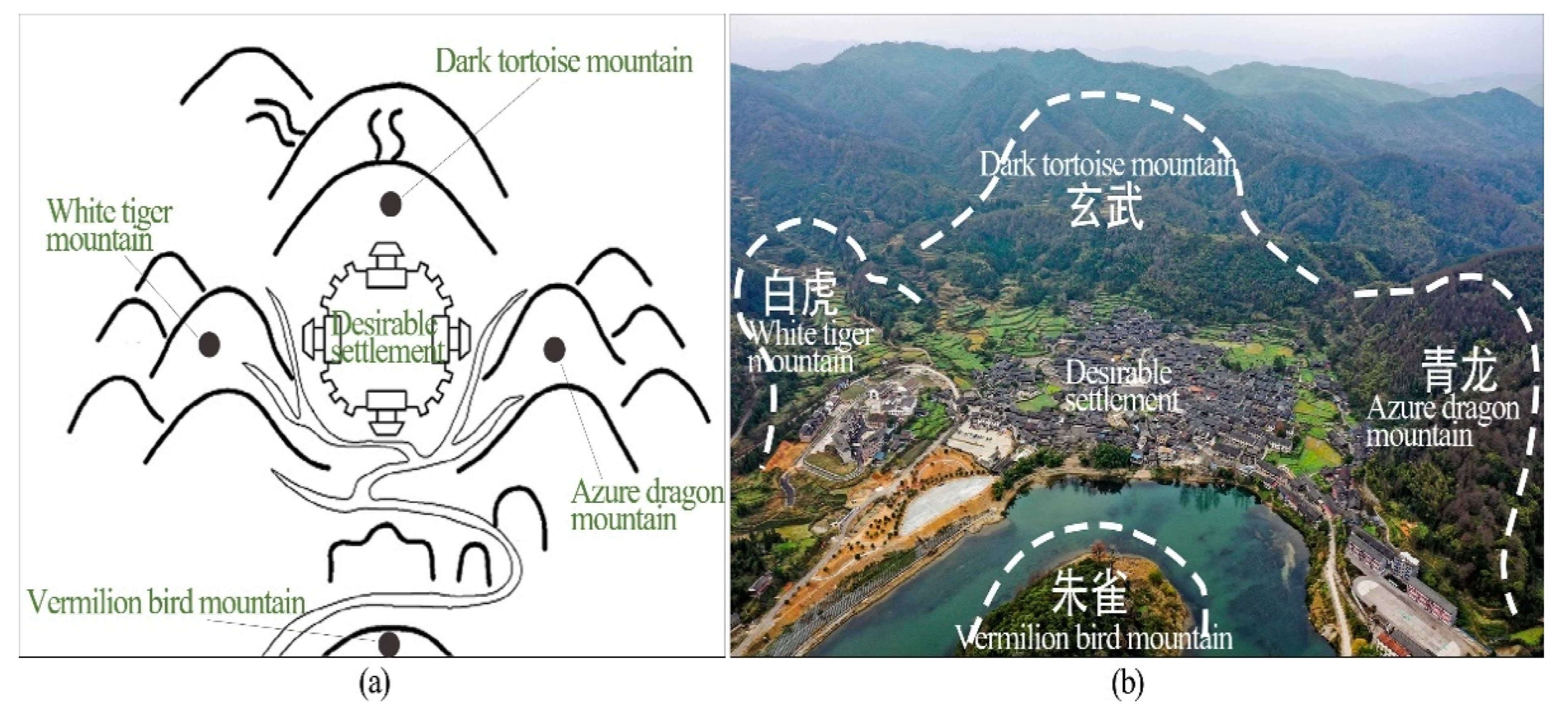
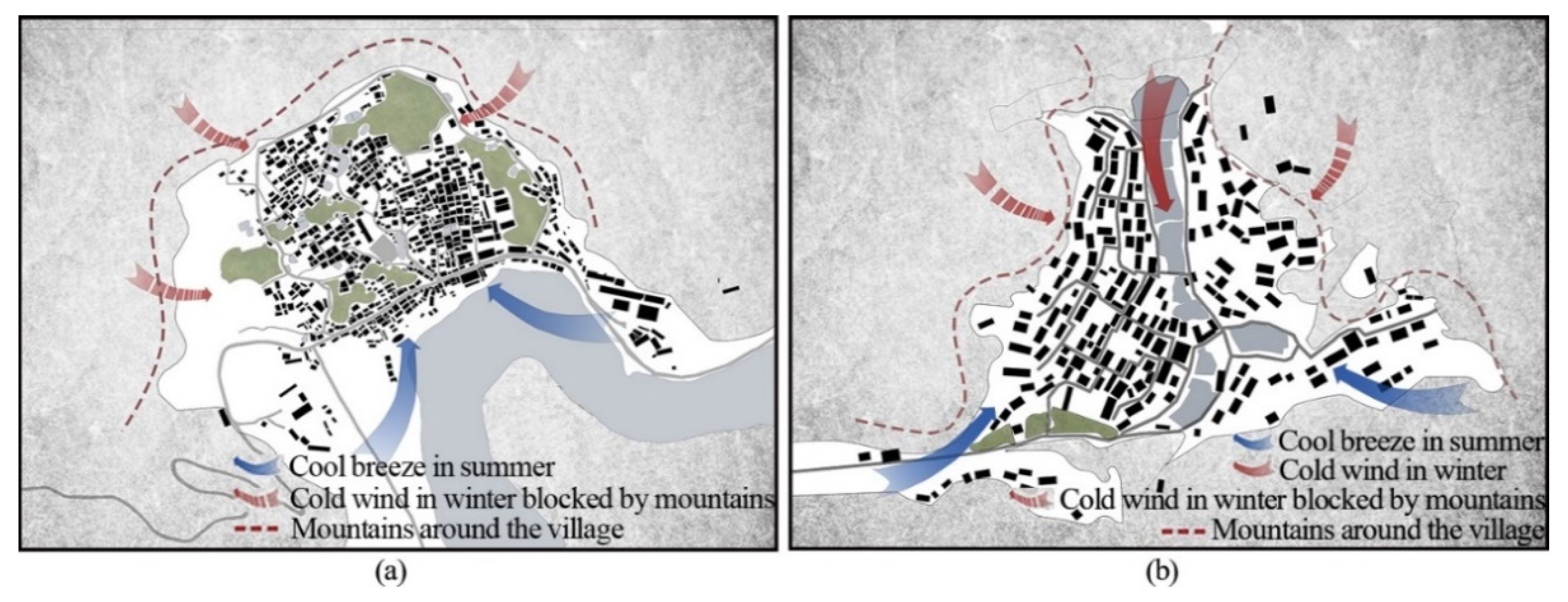

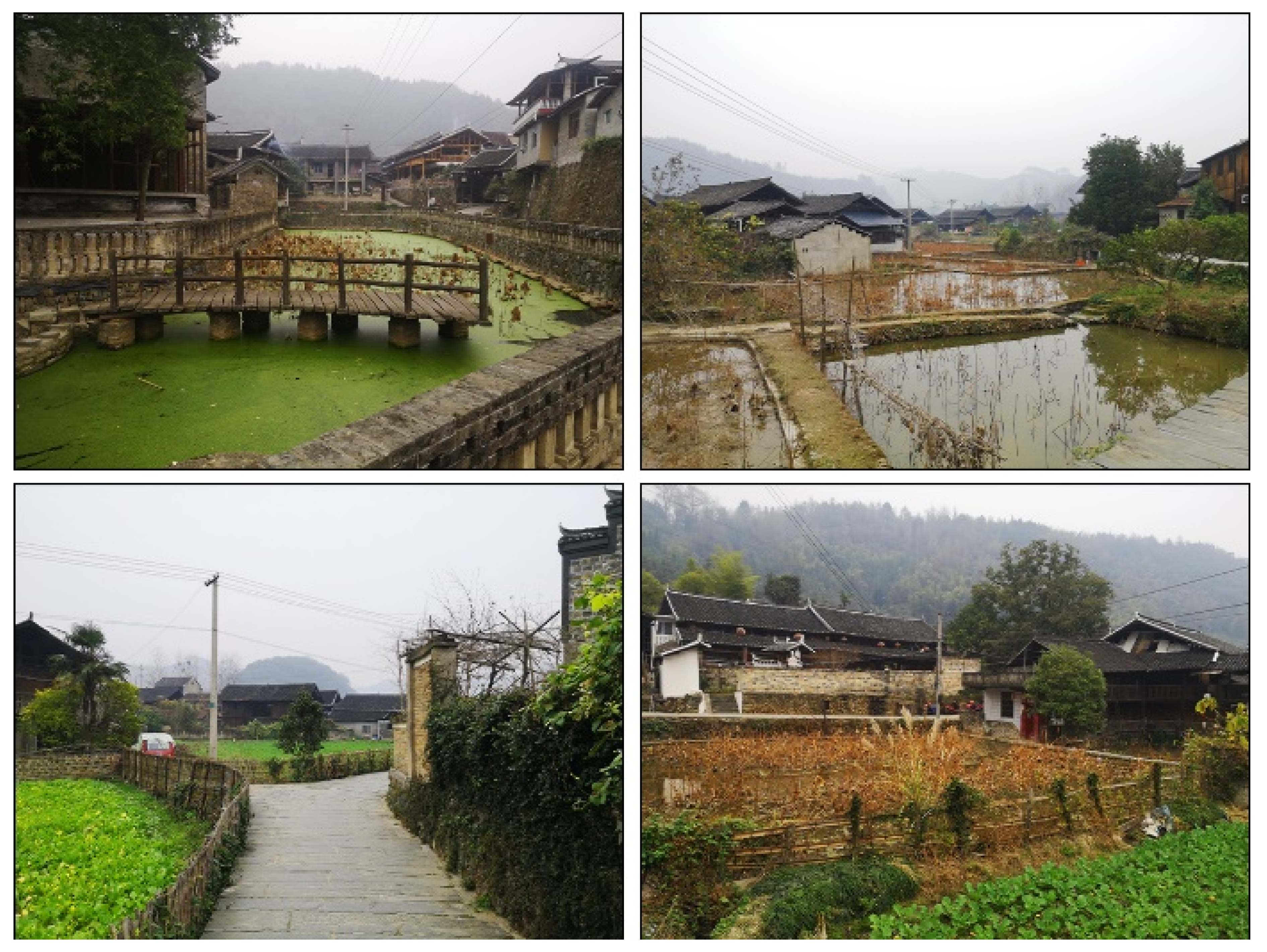

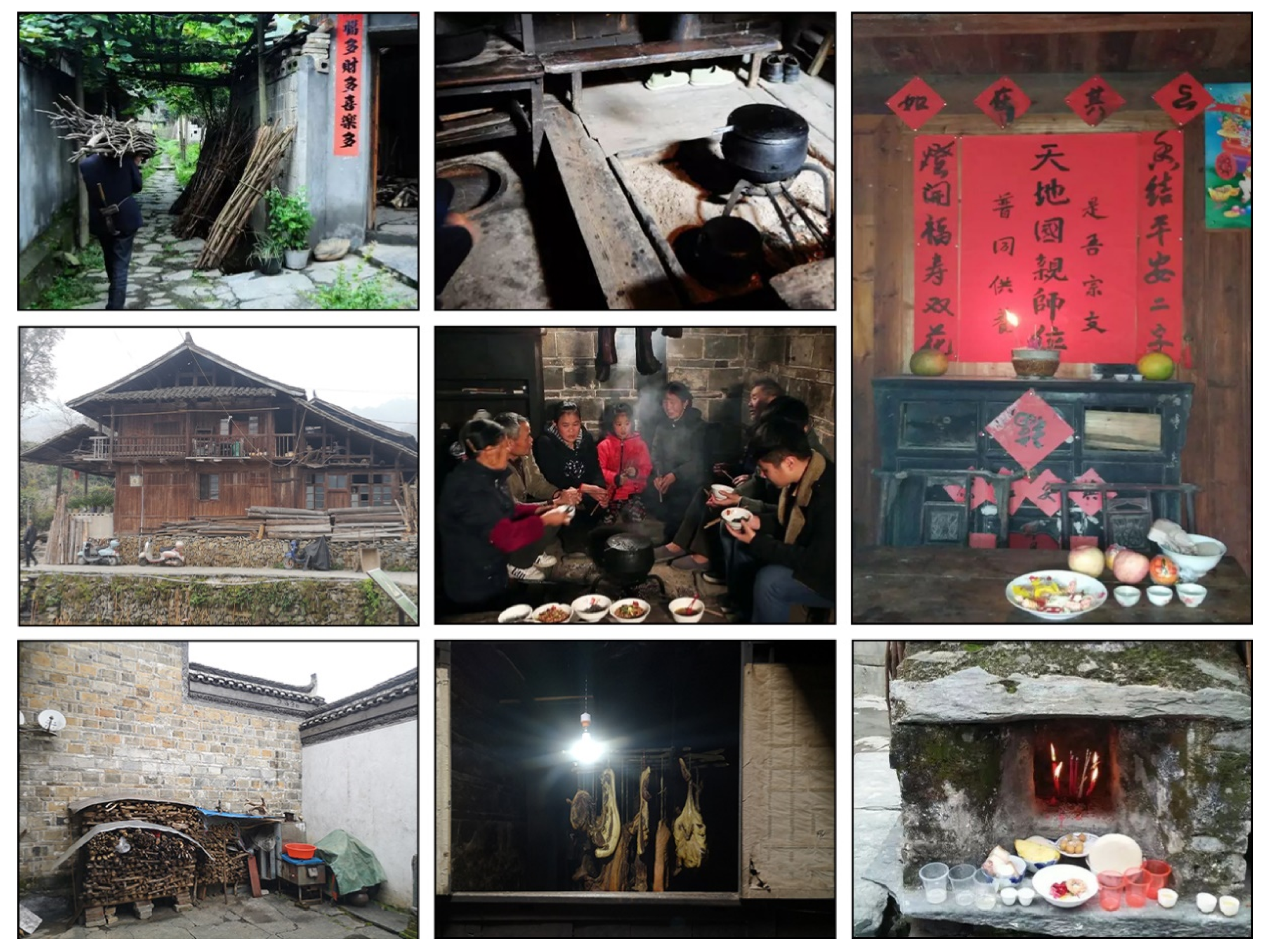
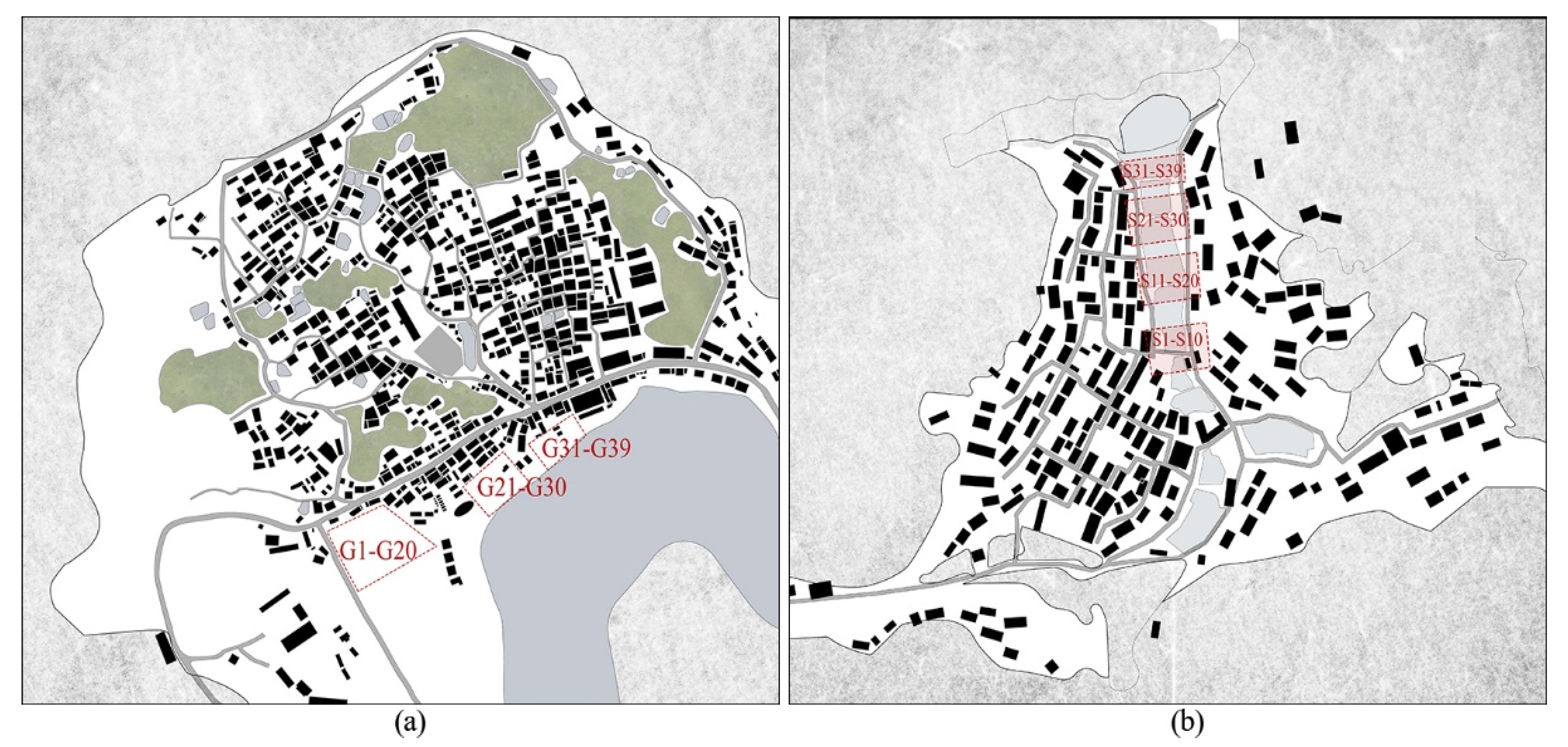



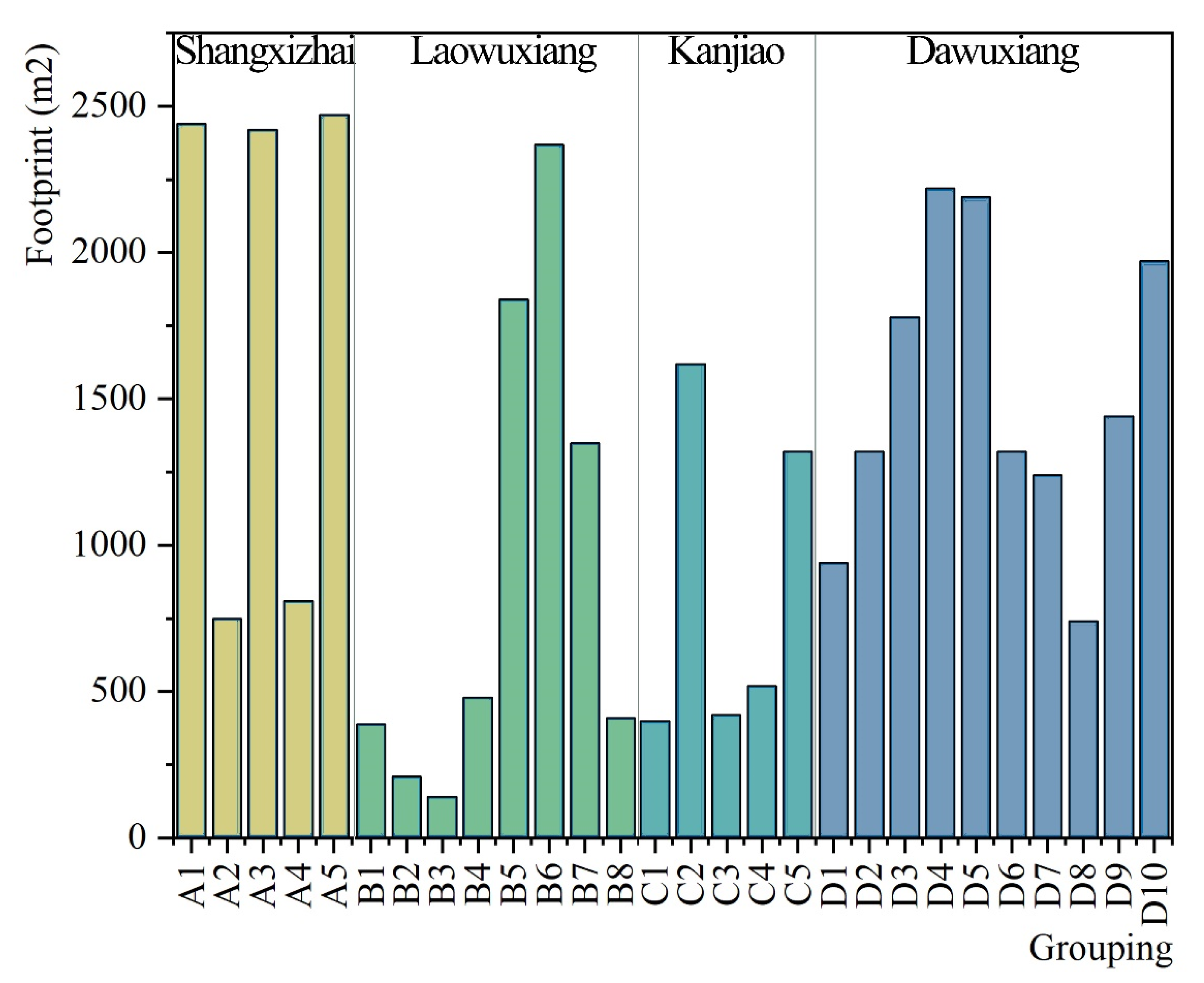
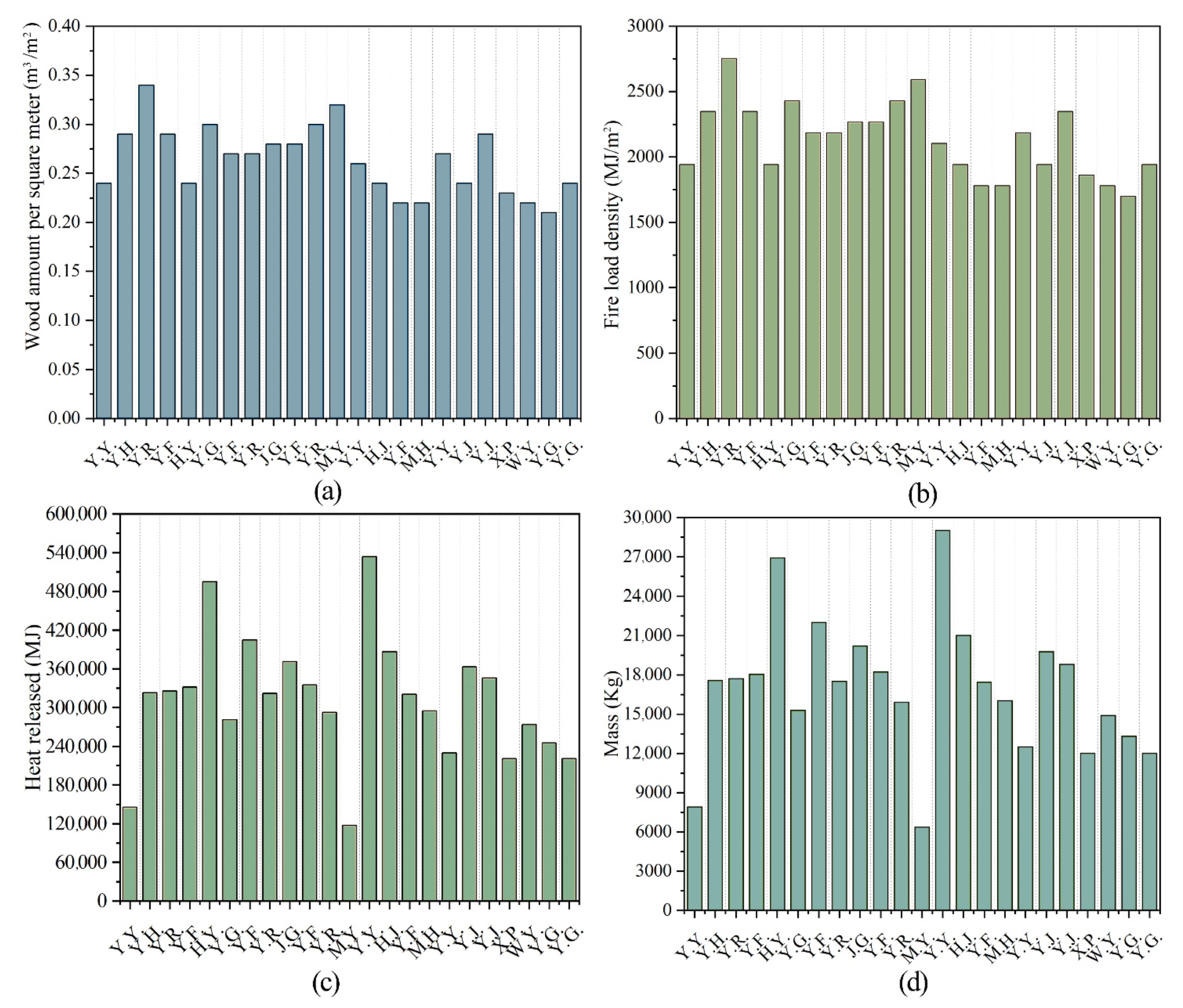
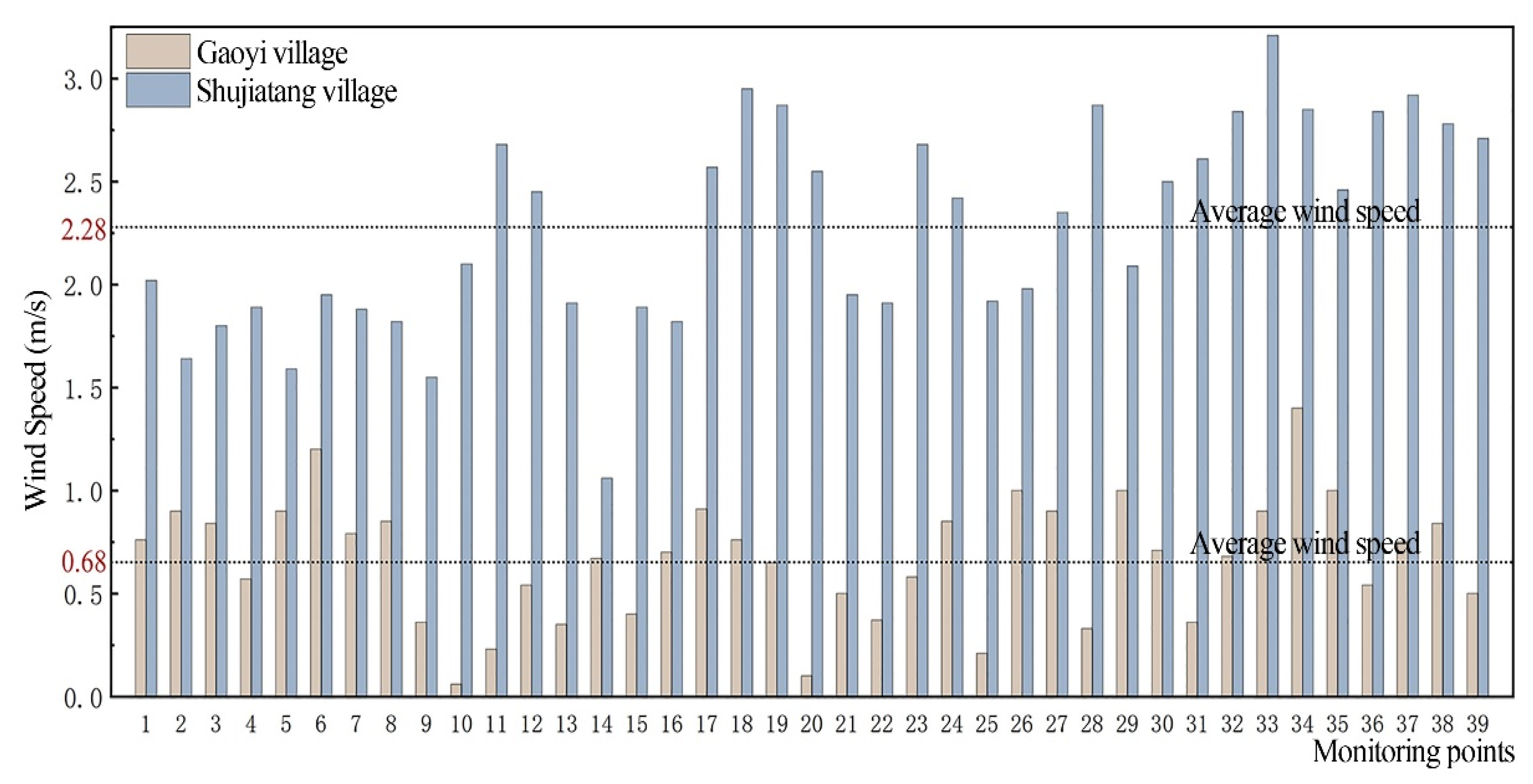



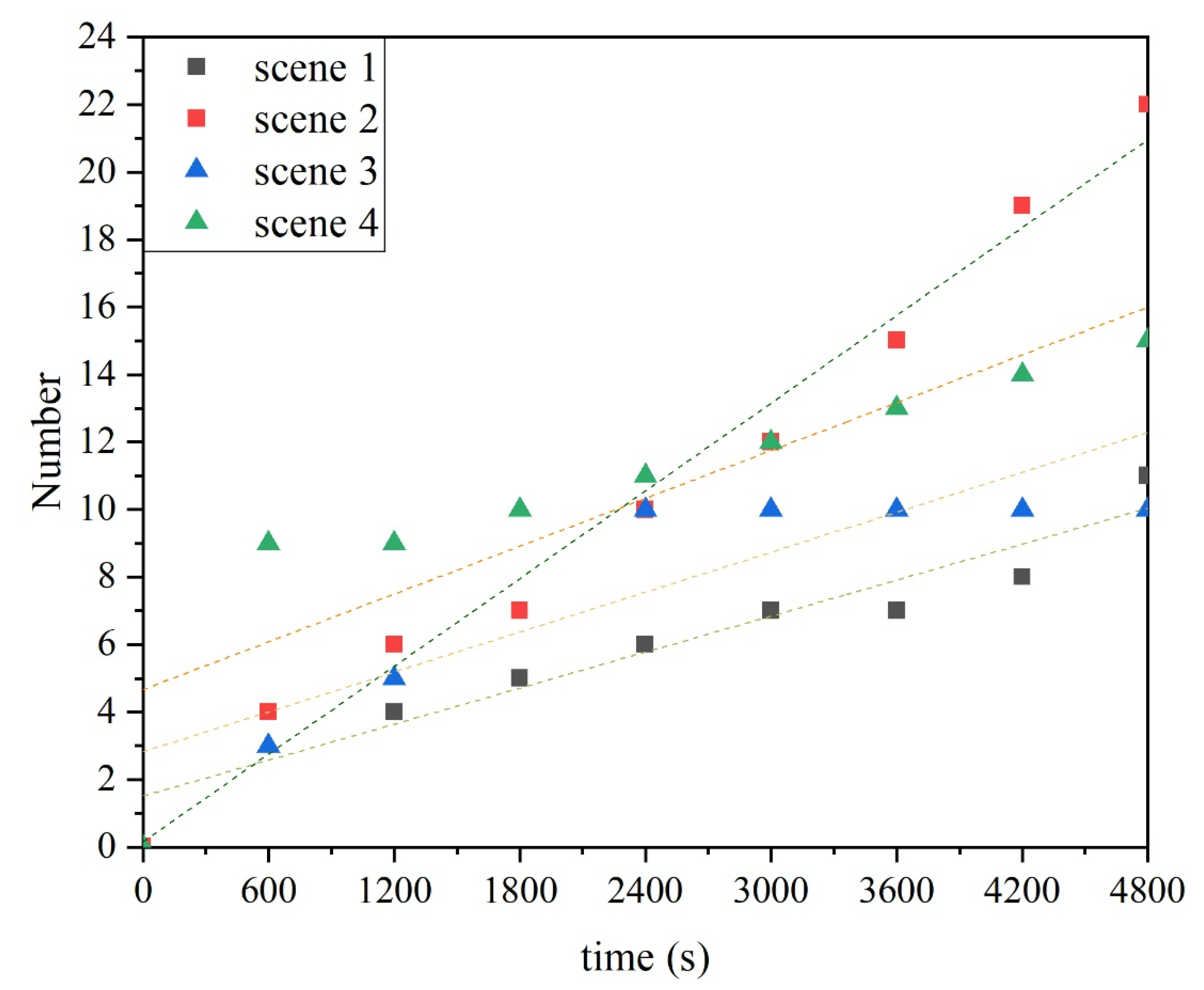
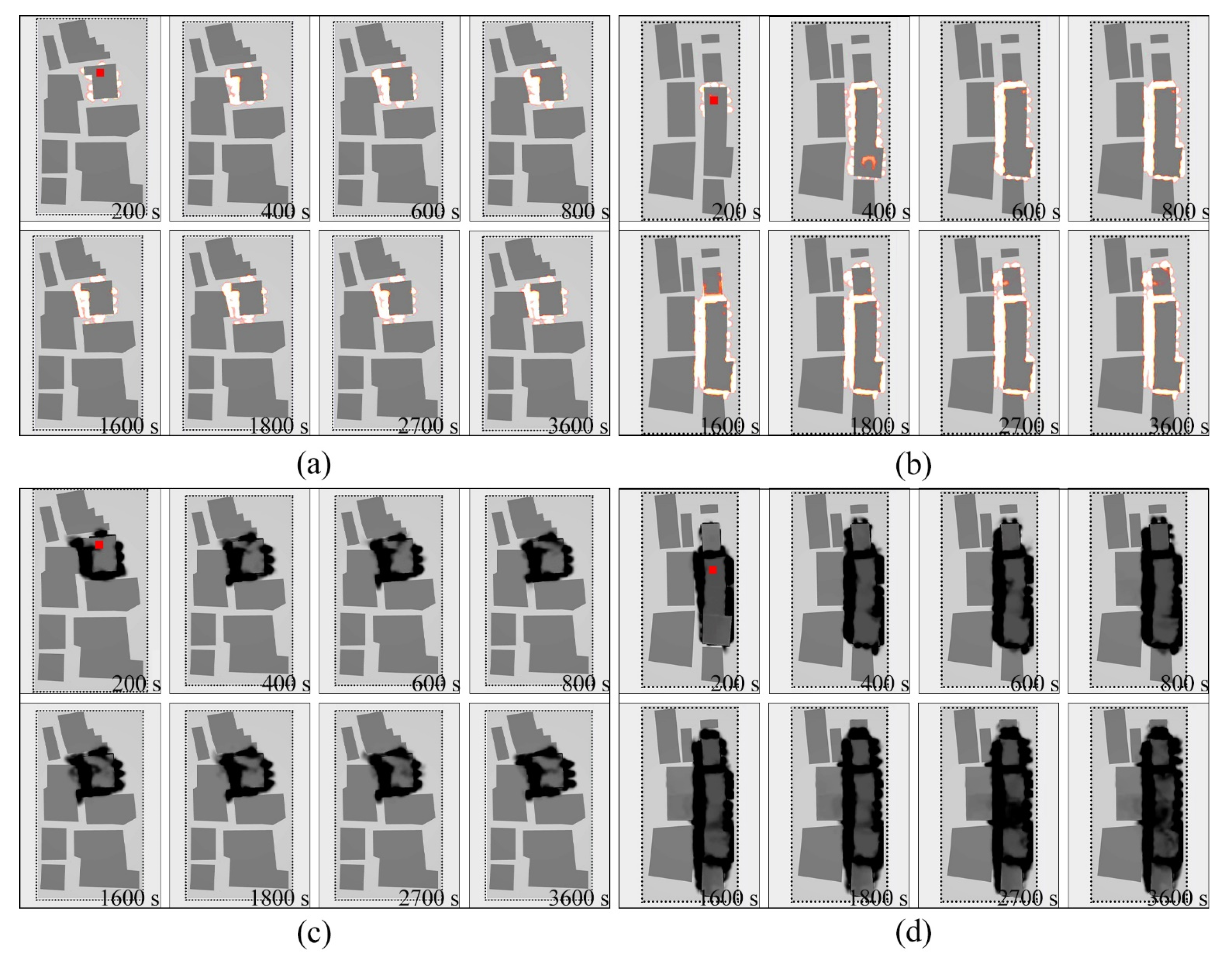
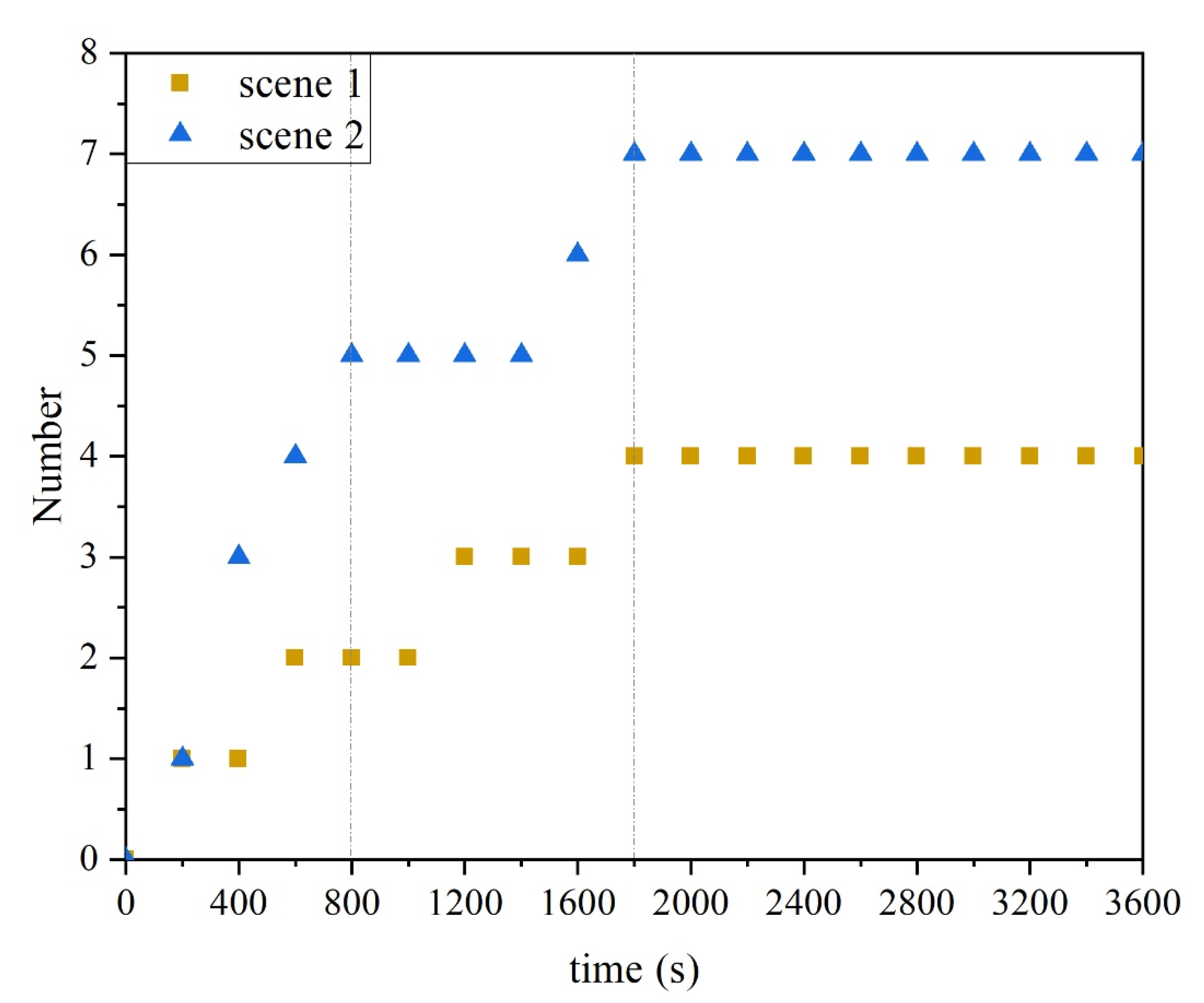
| Instrument | Parameter | Accuracy | Measuring Range | Resolution |
|---|---|---|---|---|
| Biaozhi GM630 | wood moisture | ±1.5% | 0.5–79.5% | 0.1% |
| Detu Testo 425 | Wind speed | ±0.03 m/s | 0–20 m/s | 0.01 m/s |
| Village | Scene | Fire Source | Grid Size | Wind Direction | Wind Speed | Time |
|---|---|---|---|---|---|---|
| Shujiatang Village | 1 | 6 MW | 0.15 m × 0.15 m × 0.15 m | North | 0.67 m/s | 4800 s |
| 2 | 6 MW | 0.15 m × 0.15 m × 0.15 m | North | 2.28 m/s | 4800 s | |
| Gaoyi Village | 3 | 6 MW | 0.15 m × 0.15 m × 0.15 m | Northeast | 0.67 m/s | 4800 s |
| 4 | 6 MW | 0.15 m × 0.15 m × 0.15 m | Northeast | 2.28 m/s | 4800 s |
| Model | Model Scale | Fire Source | Fire Size | Grid Size | Wind Direction | Wind Speed | Time |
|---|---|---|---|---|---|---|---|
| Crooked street | 1:1 | 6 MW | 1 m × 1 m | 0.6 m × 0.6 m × 0.6 m | Northeast | 1.5 m/s | 3600 s |
| Straight street | 1:1 | 6 MW | 1 m × 1 m | 0.6 m × 0.6 m × 0.6 m | Northeast | 1.5 m/s | 3600 s |
Publisher’s Note: MDPI stays neutral with regard to jurisdictional claims in published maps and institutional affiliations. |
© 2022 by the authors. Licensee MDPI, Basel, Switzerland. This article is an open access article distributed under the terms and conditions of the Creative Commons Attribution (CC BY) license (https://creativecommons.org/licenses/by/4.0/).
Share and Cite
Zhang, F.; Shi, L.; Liu, S.; Zhang, C.; Xiang, T. The Traditional Wisdom in Fire Prevention Embodied in the Layout of Ancient Villages: A Case Study of High Chair Village in Western Hunan, China. Buildings 2022, 12, 1885. https://doi.org/10.3390/buildings12111885
Zhang F, Shi L, Liu S, Zhang C, Xiang T. The Traditional Wisdom in Fire Prevention Embodied in the Layout of Ancient Villages: A Case Study of High Chair Village in Western Hunan, China. Buildings. 2022; 12(11):1885. https://doi.org/10.3390/buildings12111885
Chicago/Turabian StyleZhang, Fupeng, Lei Shi, Simian Liu, Chi Zhang, and Tansheng Xiang. 2022. "The Traditional Wisdom in Fire Prevention Embodied in the Layout of Ancient Villages: A Case Study of High Chair Village in Western Hunan, China" Buildings 12, no. 11: 1885. https://doi.org/10.3390/buildings12111885
APA StyleZhang, F., Shi, L., Liu, S., Zhang, C., & Xiang, T. (2022). The Traditional Wisdom in Fire Prevention Embodied in the Layout of Ancient Villages: A Case Study of High Chair Village in Western Hunan, China. Buildings, 12(11), 1885. https://doi.org/10.3390/buildings12111885





